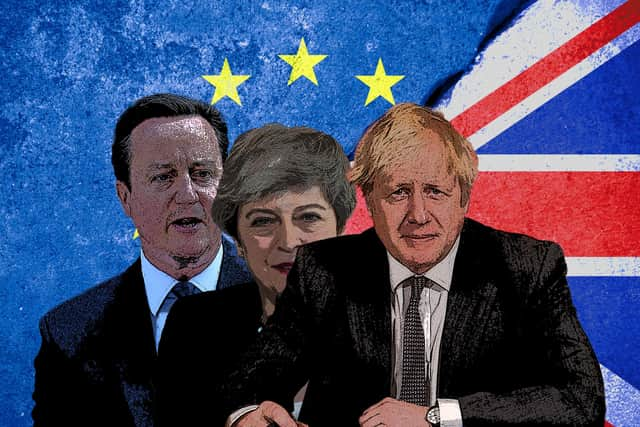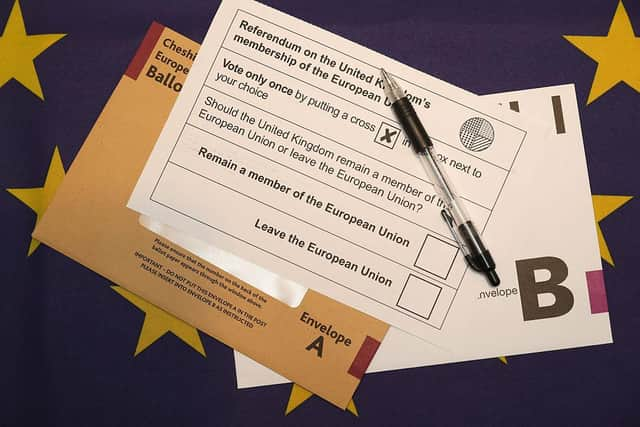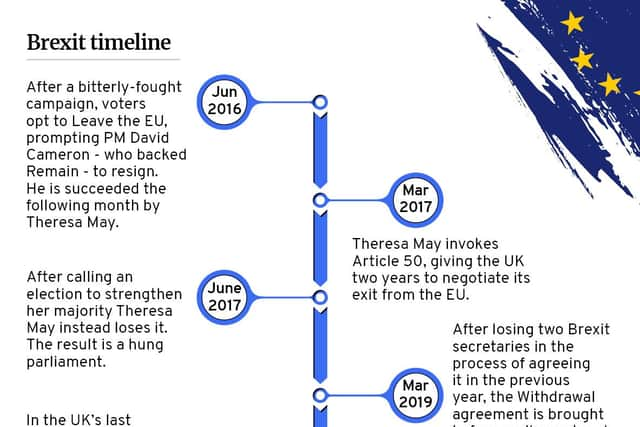Brexit timeline: what has happened between Brexit vote in 2016 - and UK leaving European Union in 2021
and live on Freeview channel 276
In the five years since the referendum took place, British politics, global politics and indeed the world have changed almost beyond recognition.
Like many momentous events, Brexit somehow feels like it happened both yesterday and in another lifetime, but that could be because it didn’t ‘happen’ but rather has been ‘happening’ for almost that entire period.
Advertisement
Hide AdAdvertisement
Hide AdWe want to hear from you: let us know what you think about this story and be part of the debate in our comments section below


Here’s a full timeline of the events that culminated in the UK officially leaving the EU in January this year.
2016
June


23 June: After a bitterly-fought campaign, 52 per cent of voters in the EU referendum back ‘Leave’, creating a political earthquake which will dominate British politics for the coming years.
24 June: Conservative Prime Minister, David Cameron, who campaigned in favour of remaining in the EU, resigns
July
Advertisement
Hide AdAdvertisement
Hide Ad13 July: Theresa May becomes Prime Minister, with David Davis appointed as Brexit secretary, or Secretary of State for Exiting the European Union


2017
March
29 March: After a high court challenge and a tense vote in parliament, Theresa May sends a letter to the EU officially invoking article 50, which gives the UK two years to negotiate its exit from the bloc
April
18 April: Theresa May calls a general election which she says will give her a bigger majority and therefore more authority with which to negotiate with the EU
June
8 June: After calling an election to strengthen her majority Theresa May instead loses it. The result is a hung parliament, with the Tories only able to cobble together a functioning majority through a deal with the DUP.
19 June Negotiations with the EU officially get underway
2018
July
Advertisement
Hide AdAdvertisement
Hide Ad6 July: The first attempt at a model for the UK’s future relationship with the EU, known as the Chequers agreement, is drawn up by Theresa May.
8 July: David Davis resigns as Brexit secretary over the Chequers agreement, and is replaced by Dominic Raab. Boris Johnson resigns as foreign secretary the following day.
November
14 November: The Brexit Withdrawal agreement is finalised and published for the first time
15 November: Dominic Raab becomes the second person to resign as Brexit secretary in the immediate aftermath of a deal being concluded. He is replaced by Stephen Barclay.
Advertisement
Hide AdAdvertisement
Hide Ad25 November: EU member states endorse the Withdrawal agreement
2019
January
15 January: Parliament votes for the first time on the Withdrawal agreement and the government is defeated by 432 votes to 202 - among the largest defeats in parliamentary history
March
12 March: The Withdrawal agreement is put before MPs again, who turn it down by a significant margin. The government is defeated by 391 votes to 242.
14 March - 29 March: After a vote to extend article 50 until 30 June passes, Theresa May requests the extension from the EU and is at first given 22 May as a new deadline, so long as the Withdrawal agreement is passed before 29 March. The Withdrawal agreement is voted on again in parliament, after being separated from the Political Declaration, but is is again voted down, by 344 votes to 286
April
Advertisement
Hide AdAdvertisement
Hide Ad5 April: Theresa May requests another extension to Article 50, until 30 June
10 April: The EU grants an extension until 31 October, or 1 June if the UK does not hold European elections.
May
23 May: The UK holds European parliamentary elections, which deliver an earth-shattering result. Nigel Farage’s new party, the Brexit Party, wins the election with 29 seats. The Lib-Dems perform well, picking up 16 seats, while Labour flounder on 10 and the Conservatives score the largest defeat of a governing party in a UK-wide election, with just four seats, or 8.8 per cent of the vote.
24 May: Theresa May announces her intention to resign as Conservative Party leader, prompted by the election result, numerous defeats in parliament and several no-confidence motions.
July
Advertisement
Hide AdAdvertisement
Hide Ad24 July: Boris Johnson wins the Conservative leadership race and becomes Prime Minister, parliament goes into recess the following day
August
28 August: Towards the end of recess, Boris Johnson announces his intention to prorogue parliament in a highly controversial move, which would limit parliament’s ability to scrutinise the Brexit legislation and make a no-deal Brexit more likely
September
3 September: 21 Conservative MPs rebel against the government on an emergency vote to prevent a no-deal Brexit by making it mandatory for parliament to approve either a Withdrawal agreement or a no-deal Brexit - the Benn Bill. The government is defeated, 328 votes to 301
4 September: The Benn Bill is again voted through by MPs at the second reading, and MPs vote against a motion by Boris Johnson to call an election in October
Advertisement
Hide AdAdvertisement
Hide Ad9 September: One of the busiest days in recent parliamentary history. The Benn Bill passes into law, the government again loses a vote on a general election, a motion compelling government figures to publish private messages about the proroguing of parliament passes, the speaker John Bercow announces his intention to resign, and Parliament is prorogue until 14 October
24 September: Or is it? The UK Supreme Court rules that Johnson acted unlawfully in advising the Queen to prorogue parliament, meaning the prorogation is null. Dramatic scenes in Westminster the next day as Parliament is hastily recalled.
October
17 October: After publishing plans to replace the Irish Backstop earlier in the month, the European Commission agrees to the new Withdrawal agreement including the Northern Ireland protocol.
19 October: During a special Saturday session Parliament amends and passes the new Withdrawal agreement, but delays consideration of it until the legislation has passed, triggering the Benn Bill. This forces Boris Johnson to write to the EU requesting a further extension until 31 January. Johnson does so, but sends two letters, the first is unsigned and requests an extension as compelled by the Benn Bill, but the second, which is signed states that Johnson believes an extension would be a mistake
Advertisement
Hide AdAdvertisement
Hide Ad21 October: The speaker cites an arcane precedent to stop the government introducing the Withdrawal bill in parliament as it is essentially the same as one already voted down
22 October: The Withdrawal bill passes through parliament by 329 votes to 299, but MPs vote against the timetable for completing the bill, meaning the UK must request a further extension until 31 January
24 October - 29 October: The government and opposition parties go back and forth over a general election in December. The proposal is turned down twice by MPs, but after the EU agrees to the 31 January extension MPs vote for a general election to be held on 12 December
December
12 December: After a relatively short but intense and heated campaign, the Conservatives secure an 80-seat majority, winning in some northern and midland constituencies which have not elected a Tory MP in decades if at all. The result is largely attributed to Johnson’s promise to “Get Brexit Done” and is seen by many as a repudiation of Labour leader Jeremy Corbyn.
Advertisement
Hide AdAdvertisement
Hide Ad20 December: Wielding his new majority, Johnson easily passes the Withdrawal Agreement, by 358 votes to 234
2020
January
29 January: After the Withdrawal agreement passes through parliament and becomes law, it is officially signed off by the European Union, with the European Parliament voting in favour by 621 to 49
31 January: As set out in the third and final extension of article 50, the UK withdraws from the European Union, and a transitional period begins which is due to end on 31 December 2020
December
31 December: After an otherwise uneventful year, the UK officially leaves the European Union
A message from the editor:
Advertisement
Hide AdAdvertisement
Hide AdThank you for reading. NationalWorld is a new national news brand, produced by a team of journalists, editors, video producers and designers who live and work across the UK. Find out more about who’s who in the team, and our editorial values. We want to start a community among our readers, so please follow us on Facebook, Twitter and Instagram, and keep the conversation going.
Comment Guidelines
National World encourages reader discussion on our stories. User feedback, insights and back-and-forth exchanges add a rich layer of context to reporting. Please review our Community Guidelines before commenting.
